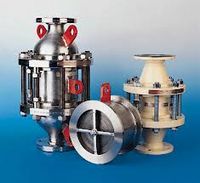Flame Arresters
Flame Arresters are devices that stop fuel combustion by extinguishing the flame.
Typical Features
- Inline Deflagration Flame Arresters
- End Of Line Deflagration Flame Arresters
- In Line Detonation Flame Arresters
- End Of Line Detonation Flame Arresters
Common Applications
- fuel storage tank vents
- fuel gas pipelines
- safety storage cabinets for paint, aerosol cans, and other flammable mixtures
- the exhaust system of internal combustion engines
- Davy lamps in coal mines
- overproof rum and other flammable liquors
Working Principles
A flame arrester functions by forcing a flame front through channels too narrow to permit the continuance of a flame. These passages can be regular, like wire mesh or a sheet metal plate with punched holes, or irregular, such as those in random packing.
The required size of the channels needed to stop the flame front can vary significantly, depending on the flammability of the fuel mixture. The large openings on a chain link fence are capable of stopping the spread of a small, slow-burning grass fire, but fast-burning grass fires will penetrate the fence unless the holes are very smallIn a coal mine containing highly explosive coal dust or methane, the wire mesh of a Davy lamp must be very tightly spaced.
For flame arresters used as a safety device, the mesh must be protected from damage due being dropped or struck by another object, and the mesh must be capable of rigidly retaining its shape during a forceful explosive event. Any shifting of the individual wires that make up the mesh can create an opening large enough to allow the flame to penetrate and spread beyond the barrier.
On a fuel storage vent, flame arresters also serve a secondary purpose of allowing air pressure to equalize inside the tank when fuel is added or removed, while also preventing insects from flying or crawling into the vent piping and fouling the fuel in the tanks and pipes.
Video
